Adding a Global Speech Profile
Overview
A Global Speech Profile is a set of speech parameters that can be used in any site within the account.
The parameters/values you define for a speech profile affect the corresponding parameters of the entities (operator groups/operators) that use that speech profile. In other words, operators/operator groups inherit some speech related values and resources and some options may be deactivated (ex: If you disable the "Speech Input" setting of "Speech Profile A", any operator using "Speech Profile A" will not have any information in his profile's "Speech In" tab (in the "Operator Details" page).
![]() Before creating a speech profile, you MUST first upload the necessary speech resources (Technical Profile(s) and/or Accent File(s)) and select the required input and output languages (ASR/TTS Speech) in the "Account" module (Account Details - Speech Tab). Once you have done this, the file(s) and selected language(s) will be available to create the intended speech profile(s).
Before creating a speech profile, you MUST first upload the necessary speech resources (Technical Profile(s) and/or Accent File(s)) and select the required input and output languages (ASR/TTS Speech) in the "Account" module (Account Details - Speech Tab). Once you have done this, the file(s) and selected language(s) will be available to create the intended speech profile(s).
Step-by-step
1. To access the "Speech Profile Details" page, click  (in the Admin Dashboard's "Control Panel"). This opens the "Speech Profile Management" page.
(in the Admin Dashboard's "Control Panel"). This opens the "Speech Profile Management" page.

2. Click ![]() and open the"New Speech Profile" page.
and open the"New Speech Profile" page.
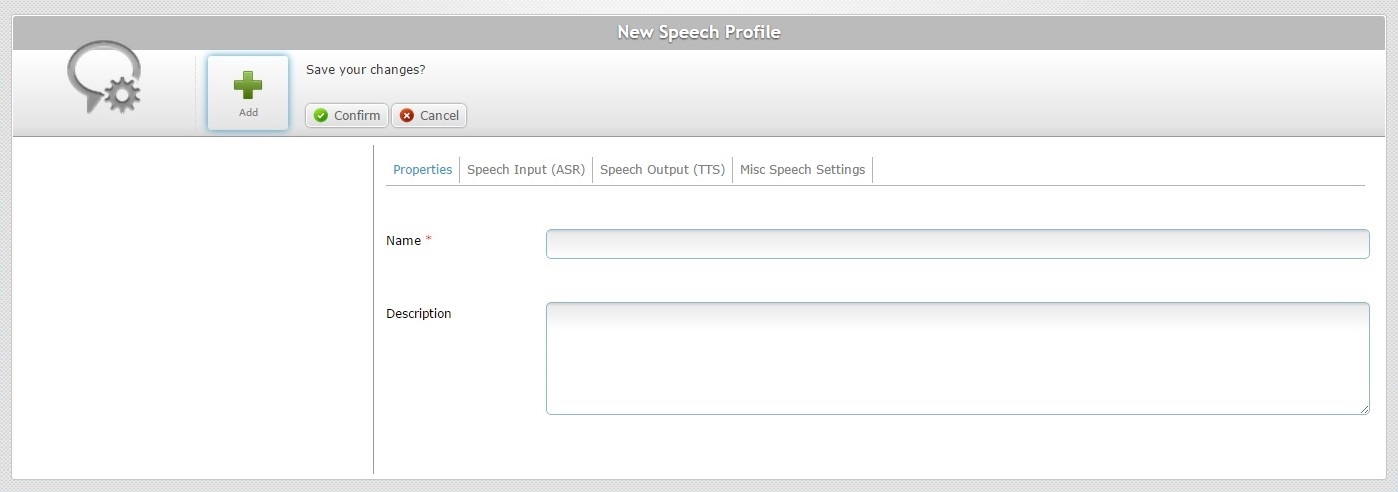
The resulting "New Speech Profile" page opens in "edit mode" and includes several tabs that need to be filled in ("Properties", "Speech Input (ASR)", "Speech Output (TTS)" and "Misc Speech Settings").
3. In the "Properties" tab (open by default), fill in the available fields. The fields marked with an asterisk are mandatory.
Name * |
Fill in the name of the speech profile.
•Use alphabetic/numeric characters (a-z; A-Z; 0-9) •Underscore and/or dash characters are allowed •Always start the entity's name with an alphabetic character |
Description |
Add any notes you may find useful. The added information is displayed in the "Speech Profiles Management" page (in the corresponding "Description" field/column) and in the "Speech Profile" drop-down of the "Operator Details" page. |
4. Continue to the "Speech Input (ASR)" tab.
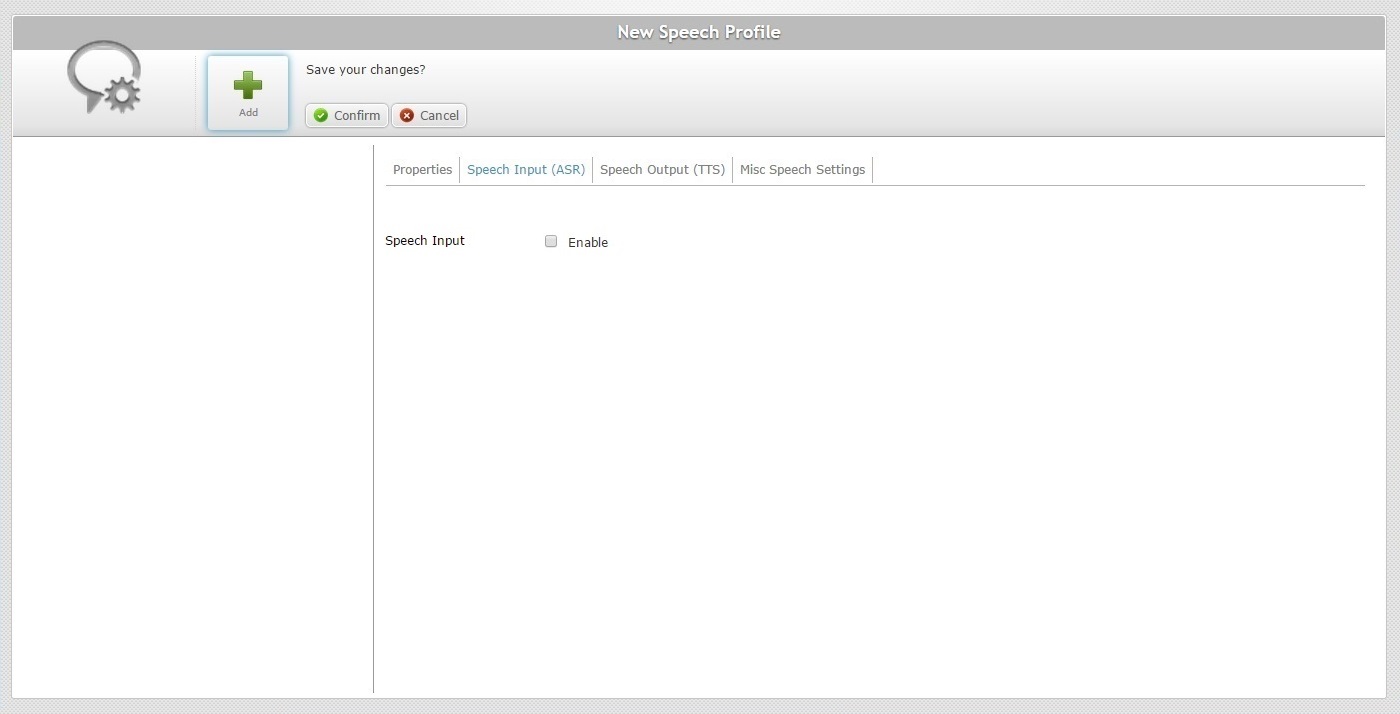
5. If you want to enable the "Speech Input" setting, check the "Speech Input" option. This will activate further speech input related options.
If the speech profile you are creating does not require this setting, continue to the next tab (step 7).
![]() If the speech input setting is disabled, any speech operator using this profile will not have any information in the corresponding "Speech In" tab of his profile (in the "Operator Details" page).
If the speech input setting is disabled, any speech operator using this profile will not have any information in the corresponding "Speech In" tab of his profile (in the "Operator Details" page).
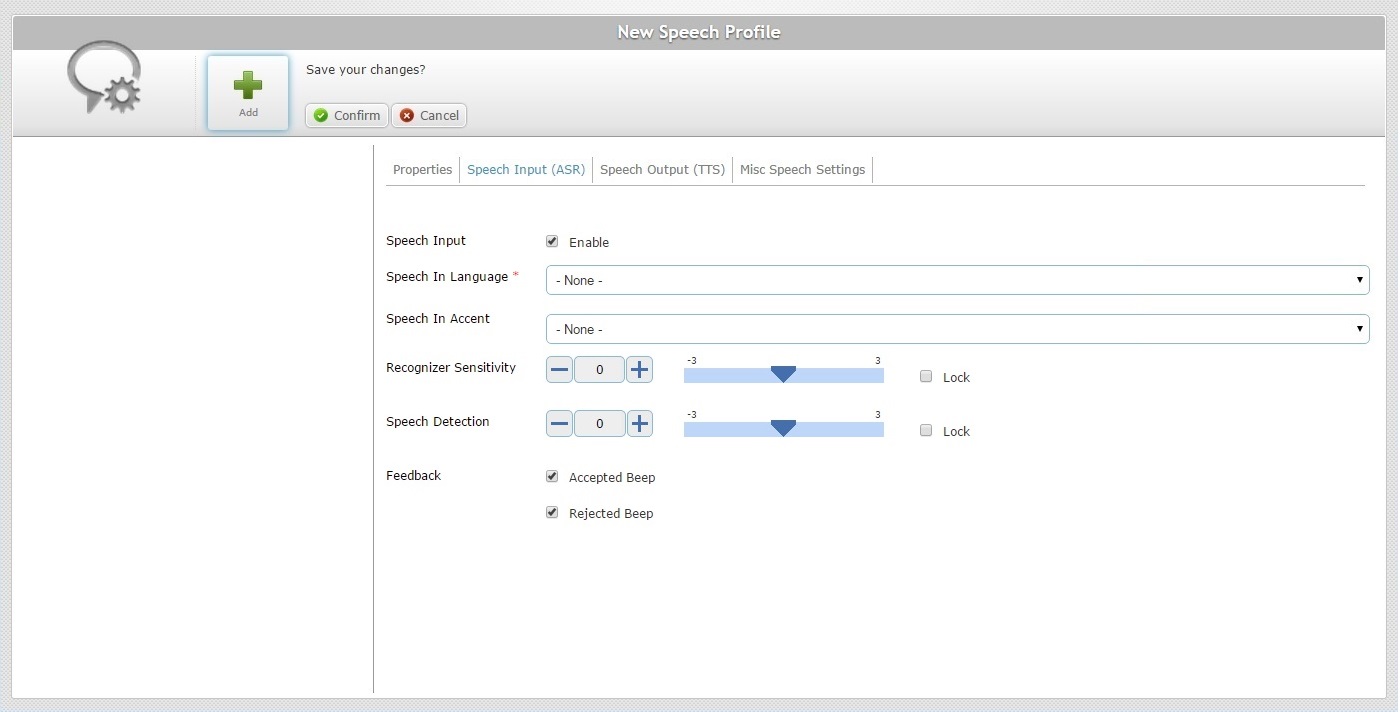
6. Fill in the mandatory fields (marked with an asterisk) and, if required, the remaining fields.
Speech In Language * |
Select the input language to be used by the operator to interact with the speech application from the drop-down list. The available choices refer to the languages you have previously selected in Account Details page - Speech Tab. |
||||||||||||||||||
Speech In Accent |
Select the accent file that stores the fine tuning of speech recognition (speech transcriptions for the original spoken word) from the drop-down list. The available choices refer to the accent files you have previously uploaded in the Account Details page - Speech Tab. |
||||||||||||||||||
Recognizer Sensitivity |
Use the slider, the plus/minus buttons or enter a recognizer sensitivity value (available values from -3 to +3). This parameter defines the general acceptance balance regarding recognized words. Its purpose is to match the operator's speech to the expected words. (Available values from -3 to +3). When setting the recognizer sensitivity value, you must take the operator's speech level into account: •a good speech -high energy/loud and clear word pronunciation. •a poor speech -low energy and bad word pronunciation. Also, consider the operator's environment and if the resulting background noise level can interfere with word recognition. Ex: Too low recognizer sensitivity dismisses background noise but does NOT accept an operator's "poor" speech.
Possible settings based on general considerations:
Fine tuning suggestions:
|
||||||||||||||||||
Speech Detection |
(Aka Microphone Sensitivity) Use the slider, the plus/minus buttons or enter a speech detection value (available values from -3 to +3). This parameter defines the speech detection levels that will "isolate" background noise from actual speech based on the received energy level. (Available values from -3 to +3). A high speech sensitivity helps detect a low energy speech (operator with a soft voice) but it increases the risk of noise processing. A low speech sensitivity reduces the risk of noise processing but requires a high energy speech (operator must speak loud and clear) for a good detection.
For operators with a loud and clear voice, define a speech sensitivity value of -1 or -2.
Note that some words start with low energy (ex: words with an initial "sh" sound) which means they might not be detected if the speech sensitivity value is too low. |
||||||||||||||||||
Lock |
Check the option(s) you want to hide in the "Operator Profile Details" page. This means it will not be possible to edit the checked (therefore, hidden) option(s) within any operator's profile. This only includes the operators associated to the operator groups that use this speech profile. The unchecked option(s) will be available in the " Operator Profile Details" page of operators that use this speech profile. |
||||||||||||||||||
Feedback |
Accepted Beep - Check/uncheck to enable/disable a confirmation beep. Rejected Beep - Check/uncheck to enable/disable an unsuccessful beep. |
7. Proceed to the "Speech Output (TTS)" tab.
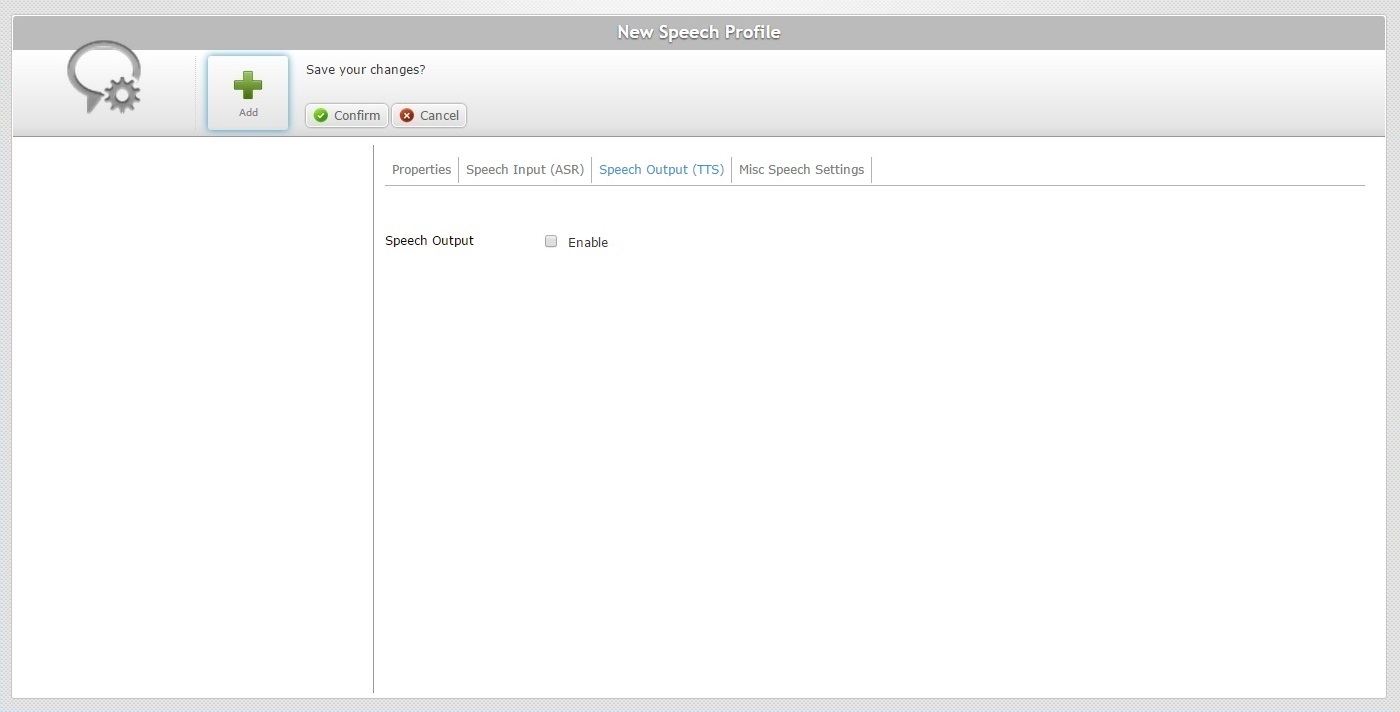
8. If you want to enable the speech output setting, check the corresponding option. This will activate further speech output related options.
If the speech profile you are creating does not require this setting, continue to the next tab (step 10).
![]() If the speech output setting is disabled, any speech operator using this profile will not have any information in the corresponding "Speech Out" tab of his profile (in the "Operator Details" page).
If the speech output setting is disabled, any speech operator using this profile will not have any information in the corresponding "Speech Out" tab of his profile (in the "Operator Details" page).
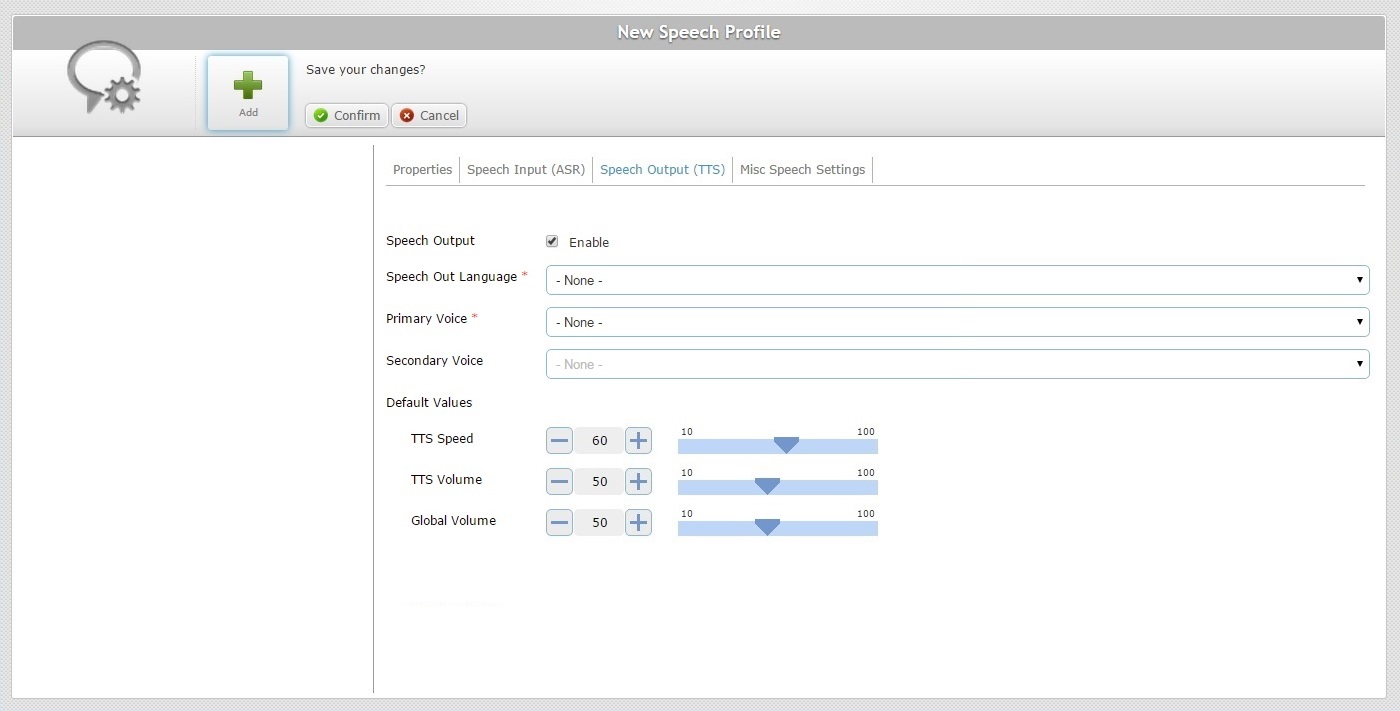
9. Fill in the mandatory fields (marked with an asterisk) and, if required, the remaining fields.
Speech Out Language * |
Select the language the operator will hear from the device. |
Primary Voice * |
Select the primary language that the operator will hear from the device. |
Secondary Voice |
As an option, select the secondary language that the operator will hear from the device. It will only be available if you have previously defined more than one compatible TTS language for the selected "Speech Out Language". See Account Details page - Speech Tab. |
Default Values |
|
TTS Speed |
Define the speed to be used by the TTS (text to Speech) engine. You can enter the value, use the plus/minus buttons or drag the slider mark to define the intended value. |
TTS Volume |
Define the speech volume to be used by the TTS (text to Speech) engine. You can enter the value, use the plus/minus buttons or drag the slider mark to define the intended value. (The TTS Volume parameter only affects the Synthesizer channel.) |
Global Volume |
Define the global audio volume for the device. You can enter the value, use the plus/minus buttons or drag the slider mark to define the intended value. (The Global Volume parameter sets the volume of all channels (recognition/rejection beep, application beep, TTS, wave player…).) |
10. Proceed to the "Misc Speech Settings" tab.
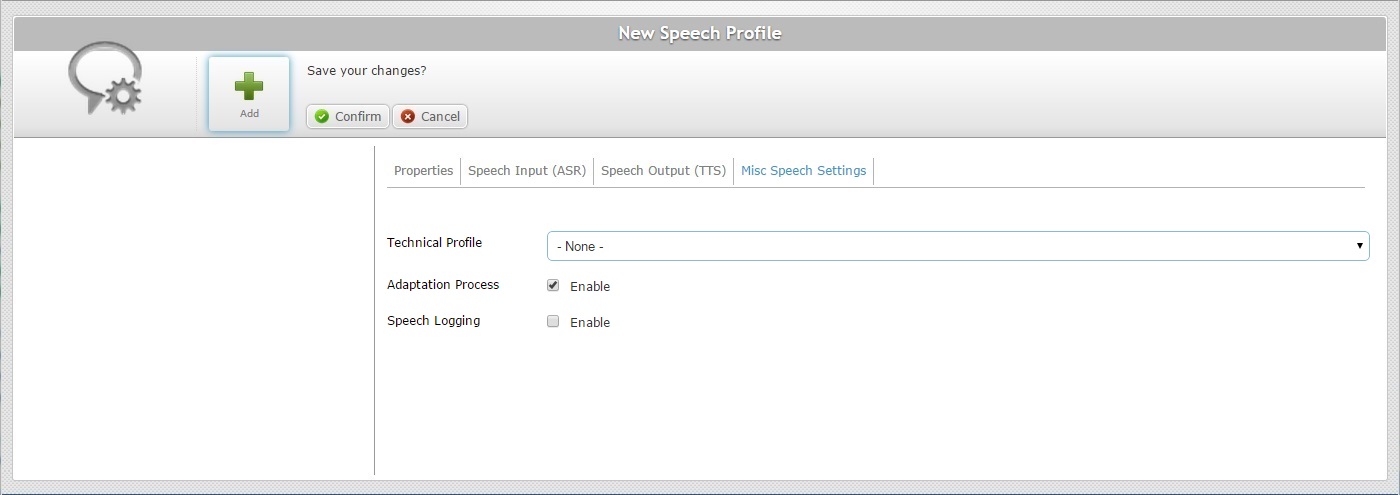
11. Fill in the available fields.
Technical Profile |
A Technical Profile is a configuration file, provided by MCL, that allows for the fine tuning of the MCL-Client behavior. Select the appropriate Technical Profile. The drop-down list displays the available technical profiles (files added in the "Speech" tab of the "Site Details" page. See Account Details page - Speech Tab). |
Adaptation Process |
This option does NOT apply to operators running MCL-Voice V4 applications. For operators handling MCL-Voice V3 applications, consider the following: Check/uncheck this option to enable/disable the use of adaptation. See Adaptation.
|
Speech Logging |
Check/uncheck this option to enable/disable the generating of speech logs. Checking this option means that the device will create speech logs of all speech interactions after operator login and will communicate those logs to the MCL-Mobility Platform account after operator logout. |
12. Once you have filled in the required fields, click ![]() to conclude the operation.
to conclude the operation.